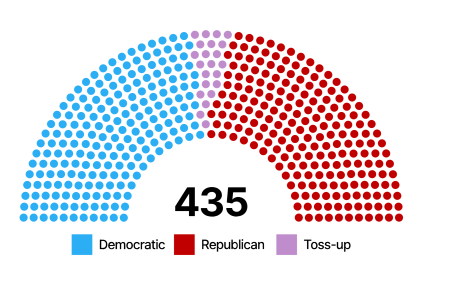Key Races We’re Watching in 2024
On top of a potential major shift in the White House—whether a new presidential administration or a shakeup to the current one—Congress could also look dramatically different with new leadership.
Currently, the two houses of Congress are deeply divided, causing legislative activity to be slow and limited. While some might welcome this development, important issues from the budget, taxes, and defense are being ignored or delayed. Even bipartisan issues such as agriculture policy is not quickly advanced in this Congress due to the division, both on policy and politics.
At the moment, Republicans hold only 218 seats, the minimum needed to hold a majority in the 435-seat House. Similarly, the Democrats hold a 51 vs. 49 majority in the Senate. With these narrow margins, every vote counts, and the absence or defection of any members often means a bill will fail to pass.
Consequently, both parties are eager to grow their numbers in 2024. While Republicans are well-positioned to take back the Senate, Democrats have several opportunities to take a majority in the House. Nevertheless, both parties see this election as crucial to their policy agenda, each hoping to have an ally in the White House to advance their respective priorities.
US House of Representatives
 The battle for control of the House of Representatives in 2024 will be determined by a smaller number of races than in the past two decades.
The battle for control of the House of Representatives in 2024 will be determined by a smaller number of races than in the past two decades.
By most analyses, only about 22 seats are competitive and up for grabs, and another couple of dozen that lean slightly Democrat or Republican, depending on the outcomes of some of the upcoming primaries. Out of 435 seats in Congress, only about 10% are competitive this year.
As we prepare for the 2024 congressional elections, keep in mind:
- Republicans are putting their resources into targeting 37 pick-up opportunities, including five Democratic seats that then-President Donald Trump carried in 2020.
- Democrats are focused on 20 seats that could send them into the majority, directing financial and organizational support to these candidates.
- This is a smaller battlefield partly due to redistricting, which has reduced the number of seats in play in recent years.
- Interestingly, states like New York and California are not competitive in the presidential race but have a number of toss-up seats in the House that could go either way. The lack of presidential coattails in these races make them even more dynamic, and it will likely lead the incumbents to localize these races while taking on more responsibility for messaging and spending.
- So far, Democrats have a financial edge, with many incumbents and Democratic candidates outraising their GOP rivals during the first and most recent quarter of 2024.
US Senate
 In the Senate, there are 34 seats up for election in 2024, including a special election in Nebraska. Currently, the Senate has 51 Democrats (including three independents who align with the Democrats) and 49 Republicans.
In the Senate, there are 34 seats up for election in 2024, including a special election in Nebraska. Currently, the Senate has 51 Democrats (including three independents who align with the Democrats) and 49 Republicans.
The key points to know about the Senate races are:
- Republicans can retake control with a net gain of two seats or by winning the 2024 presidential election along with a net gain of one seat.
- With Joe Manchin’s retirement, West Virginia is virtually a lock for GOP pickup, which means Republicans only need one other seat to gain the majority.
- Clearly, Democrats are facing an uphill battle to maintain control. They need victories for all their incumbents, including successful campaigns for open seats currently not held by Republicans in Arizona, Michigan, and Maryland, as well as Biden’s re-election.
- Democratic incumbents will have particular difficulties. Democrats must defend vulnerable positions: Senators Tester (Montana), Brown (Ohio) and Casey (Pennsylvania).
Important Congressional Races in 2024
CA-41
Longtime incumbent Ken Calvert (R) is being challenged by Will Rollins (D) in this southern California district. Rollins ran against Calvert last election cycle and came within 5 percentage points of winning. This year, Rollins should have plenty of resources and a higher name identification in this crucial Inland Empire seat. Along with the seats of a large group of other vulnerable California Republicans, including John Duarte (R), Mike Garcia (R), David Valadao (R), Young Kim (R), and Michelle Stee (R), this is a make-or-break seat for Democrats to win back the House.
NY-17
Freshman New York Republican Mike Lawler (R) upset party leader Sean Patrick Maloney (D) in a stunning victory in 2022 and shocked a lot of political professionals. But this year, Lawler is being challenged by former US Representative Mondaire Jones (D), who served one term in the House before being redistricted out of his seat. While Jones has outraised Lawler so far for this Hudson Valley seat, they both have about the same cash in the bank for the sprint to November. Lawler joins other vulnerable New York Republicans Marc Molinaro and Nick LaLota in constituting the “majority makers” from New York that the GOP needs to retain the House.
MI-7
Three-term Democratic Representative Elissa Slotkin (D-MI) is seeking a promotion to the US Senate, leaving her mid-Michigan seat open. The district is centered around the state capital Lansing and includes some Detroit suburbs in Oakland County. Vying for the seat are two former state lawmakers who both served in the state Senate, Republican Tom Barrett (R) and Democrat Curtis Hertel (D). Republican Barrett challenged Slotkin for the seat last cycle and lost by only about 5 percentage points despite being massively outspent by Slotkin. He now returns with greater name identification and no incumbent in the seat. This textbook Michigan swing district has gone for both Trump and Biden by less than one point in the respective past two presidential races, where working class union voters have a huge impact. Expect a close race where Barrett tries to focus on Biden and national issues while Hertel tries to leverage the Democratic machine and his family’s political network as the son of a former state House speaker and the nephew of a former Michigan congressman.
OH- 9
Elected in 1982, Progressive Congresswoman Marcy Kaptur (D) is the longest serving woman in congressional history. But in recent years, not only has Ohio changed, but so has the composition of her Toledo-based district. This year, Republican State Representative Derek Merrin (R) has thrown his hat into the ring against Kaptur. Merrin is a war veteran and gained Donald Trump’s endorsement in the primary. This race will largely center on whether Congresswoman Kaptur still understands and represents her district and whether Merrin is too MAGA for the district. Expect Merrin and his Republican allies to try and paint Kaptur as out of touch and too progressive for this Northeast Ohio district.
OR- 5
Freshman Representative Lori Chavez-DeRemer (R) will face a not-so-new challenger in state Representative Janelle Bynum (D). The two previously faced off for a state House seat in 2016 and 2018, with Bynum winning both times by 2 and 8 points respectively. Despite Chavez-DeRemer now holding an incumbency advantage, this district voted for Biden by double-digits. The district stretches from the Portland suburbs to Bend and includes part of the Willamette Valley. Expect both sides to spend heavily on this important Oregon race, which will be hard for Republicans to retain.
PA-7
Susan Wild (D), a moderate Democrat, took over for former moderate Republican Charlie Dent (R-PA) in 2018 in a competitive Northeast Pennsylvania district. Wild has described the heart of her district as “once an Obama county” to now being Trump country, which is reflective of the changes in the voting habits of working-class rural Pennsylvanians over the past few cycles. The question in this race is if Wild’s moderate politics can help her retain this Lehigh Valley seat against GOP state Representative Ryan Mackenzie (R). House Speaker Mike Johnson recently campaigned and helped raise money for Mackenzie, which is a sign of just how important this possible district flip is for Republicans.
Key Senate Races
Montana
Incumbent Jon Tester (D) has done a masterful job navigating the issues as a Democrat in one of the most Republican states in the nation. He regularly emphasizes his connection to the state and advocacy for its industries, especially agriculture. However, the Republican strength in ruby-red Montana might be too much for him this election cycle. He is being challenged by Navy Seal and business owner Tim Sheehy (R). The latest public polling shows Sheehy with a slight lead after being down by as much as double digits.
Ohio
Sherrod Brown (D) is a populist progressive in an increasingly Republican state. He is running against Trump-aligned candidate Bernie Moreno (R). If Brown is able to continue his appeal to populist white working-class voters along with the traditional Democratic coalition that includes minorities and young voters, he might have a chance to hold his seat. The public polling to date has Brown in the lead, but expect Moreno to start building a narrative against Brown that he no longer represents the new Ohio voter that has voted for Donald Trump twice. heir consumers and their industry so they can effectively lead in 2025 and beyond.
Pennsylvania
Similar to Ohio, Pennsylvania has become a very different place since 2016. While still a solidly Democratic state at the presidential level, white working-class voters will play an important role in this race as well. Senator Bob Casey (D) and his Democratic allies must ensure that minority voters in Philadelphia and Pittsburgh get to the polls despite some softness in their support for the top of the ticket. Meanwhile, Dave McCormick (R), a former hedge fund executive and husband of former Trump official Dina Powell, must show he can relate to the suburban and rural voters throughout the state. The “Alabama T” between Philly and Pittsburgh needs a strong showing to throw out an established pol and scion of a political dynasty like Casey.
For more on global elections in 2024, EGA Election HQ is your guide to the moments that matter, what comes next, and what all of this means for industries and sectors. For counsel or tow get in touch, reach out to Elections@edelmanEGA.com.



